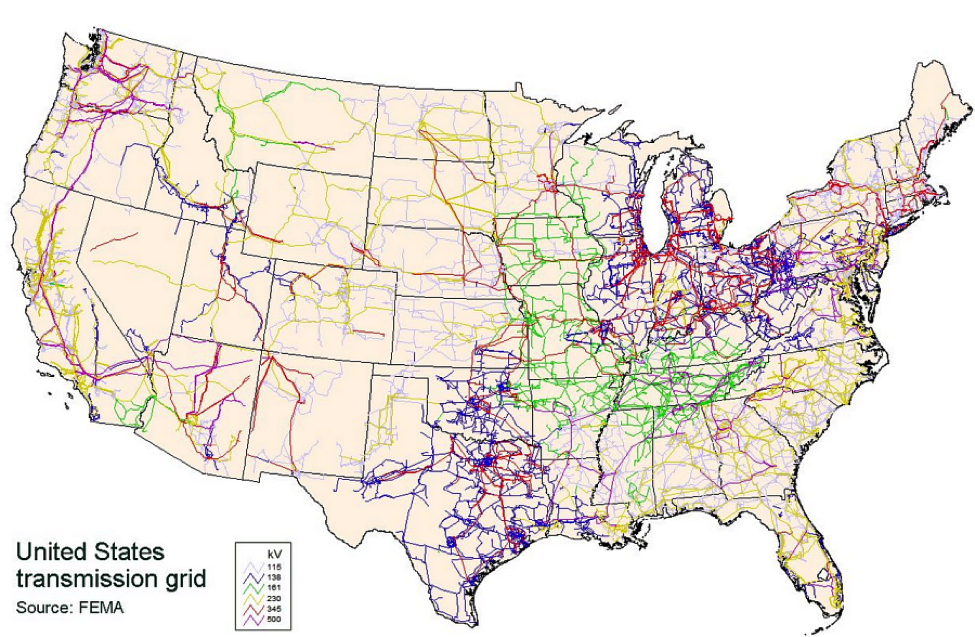9.2. Smart Grid and Demand Response Technologies
National electric power infrastructure, also called “the grid”, has been developing over more than a century and plays an important role in the nation’s energy security (Figure 9.2). Electricity production traditionally relies on a steady fuel supply (primarily fossil fuels), which would keep the power plants operating on the permanent basis. Eventual switching from the traditional fuel-burning plants to cleaner alternatives requires redesigning the grid in such a way that it properly responds to the sharp variations in demand, adequately compensates for the intermittent operation of the renewable energy systems, and can interact with distributed power generation systems.

The transmission grid shown in the figure above shows the interconnection of power generating facilities with distribution sub-stations. The local distribution grid is designed to supply power to end users and usually has a radial structure. While some of the components of the grid are subject to renovation, it is not the physical structure of the grid that is the focus of current redesign efforts; it is the informatics component that is supposed to bring the grid to a new level of intelligence. Hence, the interactive combination of information technologies and transmission systems creates the smart grid system.
Reading Assignment:
Read the following article to learn about the smart grid and associated demand response technologies in more detail. Beyond the background, this article also provides a nice illustration of how the incorporation of demand response tools influences the real-life power demand curves
Journal article: Taqqali, W.M. and Abdulaziz, N., Smart Grid and Demand Response Technology, 2010 IEEE International Energy Conference, p. 710-715.
This article is available online through the Penn State library system and in Module 9 in Canvas.
Introduction of the demand response technologies is especially relevant to the power supply for buildings. According to US DOE (DOE 2007), buildings in the US consume around 72% of total electricity, and sensitive regulation of building energy demand is considered a major factor in sustainable development. Transitioning buildings to the smart grid is a complex task, which requires efforts in three areas:
- legislation to mandate the government and business actions;
- standard and technologies enabling building-utility communications;
- business model to balance the demand-response interactions. The following article describes how these three factors can be synergistically combined to radically change the way building electricity use is managed.
Supplemental Reading:
This article discusses the prerequisites of applying automated demand response technologies for power management and provides a case study of implementation of BACnet - a tool for load management and utility communication:
Journal article: Bushby, S.T. and Holmberg, D.G., Advancing Automated Demand Response Technology, ASHRAE Transactions, 2009, Volume 115, Issue 1, pp. 333-337.
This article is available online through the Penn State library system (see e-Reserves) and in Module 9 in Canvas.
Based on what you learned from these readings, please answer the following self-check questions:
Check Your Understanding
1. What are the key elements of the Smart Grid?
Click for answer.
- Advanced Metering Infrastructure (AMI)
- Demand Response
- Optimization and self-recovery
- Integration of large-scale renewable energy
- Integration of large-scale energy storage
- Integration of electric vehicles
2. The Demand Response system helps manage the peak power consumption via
A. direct access to consumer’s appliances
B. signaling customers about shifting tariffs during peak hours
C. temporary reducing or switching off the power supply
D. working out commitment from users to shed load at specified conditions
Click for answer.
3 What three layers are distinguished in the Smart Grid infrastructure?
Click for answer.
- power layer (power transmission and distribution structure)
- communication and control layer (including sensing and control devices)
- application layer (data analysis and feedback)
4. Which legislation in the US (year?) mandated the actions for the Smart Grid development?
Click for answer.
Supplemental Reading on Smart Grid:
Book chapter: Gevorkian, P., Large Scale Solar Power Systems: Construction and Economics. Chapter 10: Smart Grid System Deployment and Economics, pp. 203-220.
This book chapter overviews many things about the Smart Grid that have been already described in other reading assignments. Look on page 112 for examples of some physical and informational technologies that facilitate smart grid operation. This book is available online through the PSU Library system.
Government document: U.S. DOE, The Smart Grid: An Introduction
